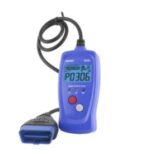The OBDII trouble code P0341 can be a source of concern for vehicle owners and mechanics alike. This diagnostic trouble code (DTC) signals that your vehicle’s Powertrain Control Module (PCM) is detecting an issue with the camshaft position sensor circuit, specifically a Range/Performance problem. But what does this really mean, and how can you address it? Let’s delve into the specifics of the Eobd/obdii P0341 code to help you understand and resolve this issue effectively.
Understanding the Camshaft Position Sensor and Code P0341
The camshaft position sensor plays a critical role in your engine’s operation. It’s designed to monitor the position of the camshaft, relaying this information back to the PCM. This data is crucial for several engine management functions, including:
- Fuel Injection Timing: Precisely timing when fuel is injected into each cylinder for optimal combustion.
- Ignition Timing: Ensuring the spark plugs fire at the correct moment for efficient power delivery.
- Valve Timing (in some vehicles): Contributing to variable valve timing systems for improved performance and fuel economy.
Code P0341 arises when the PCM detects a discrepancy between the expected readings from the camshaft position sensor and the actual signals it receives. This often manifests as an inconsistency in the number of pulses detected by the sensor during a specific number of engine revolutions. Essentially, the PCM isn’t seeing the camshaft position sensor data it anticipates, indicating a potential malfunction within the sensor circuit or related components.
In some instances, particularly in older vehicles or those without a dedicated camshaft position sensor, a P0341 code accompanied by other related codes might mistakenly point to the camshaft sensor. In these cases, the root cause could actually lie in faulty ignition components such as ignition coils or spark plugs, which can interfere with the crankshaft position sensor readings and trigger a false P0341 code.
Diagnosing the Root Cause of P0341
When troubleshooting an eobd/obdii p0341 code, a systematic approach is essential. Here’s a step-by-step guide to help you pinpoint the problem:
-
Visual Inspection of Wiring and Connections: Begin by carefully examining the camshaft position sensor wiring and connectors. Ensure the wiring is not routed too close to high-voltage ignition components like coils and spark plugs. Proximity to these components can lead to electromagnetic interference, heat damage (burning, chafing, or melting), and ultimately circuit malfunction. Check for any signs of corrosion or looseness in the connectors, as these can cause intermittent signal loss and trigger the P0341 code.
-
Reluctor Wheel Inspection: The camshaft position sensor typically works in conjunction with a reluctor wheel (also known as a tone wheel or pulse wheel) attached to the camshaft. This wheel has teeth or notches that pass by the sensor, generating the signals that the PCM reads. Depending on your vehicle’s make, model, and engine configuration, you might be able to visually inspect the reluctor wheel through the cam sensor port. If not, accessing it may require removing the camshaft position sensor, or potentially components like the intake manifold, to gain a clear line of sight. Look for any damage, debris, or misalignment of the reluctor wheel, as these issues can disrupt the sensor’s readings.
-
Symptom Evaluation: Beyond the presence of the P0341 code and the illuminated Check Engine Light (Malfunction Indicator Light – MIL), be aware of other potential symptoms. A common symptom is an engine that cranks but fails to start. In some cases, the PCM might enable a “limp-in” or “limp-home” mode, allowing the engine to run, but with reduced power and poor fuel economy. These symptoms, combined with the P0341 code, strongly suggest a camshaft position sensor circuit issue.
Resolving the P0341 Code and Restoring Engine Performance
Addressing the eobd/obdii p0341 trouble code effectively often involves component replacement or repair. Here are the common solutions:
-
Camshaft Position Sensor Replacement: If, after thorough diagnosis, the camshaft position sensor itself is identified as the faulty component, replacement is usually the most straightforward solution. However, before replacing the sensor, double-check the wiring and reluctor wheel to ensure the problem isn’t stemming from these areas.
-
Wiring Repair or Replacement: Damage to the wiring harness or connectors associated with the camshaft position sensor circuit requires repair or replacement. This might involve splicing damaged wires, replacing corroded connectors, or rerouting wiring away from heat sources or ignition components to prevent future issues.
-
Reluctor Wheel Repair or Replacement: If the reluctor wheel is found to be damaged or misaligned, it will need to be repaired or replaced. This can sometimes be a more complex repair, potentially requiring camshaft removal depending on the extent of the damage and vehicle design.
It’s important to note that eobd/obdii p0341 might not be the only code present. Related trouble codes in the P0340-P0349 range specifically pinpoint camshaft position sensor circuit malfunctions. Codes P0365-P0369 indicate similar circuit issues but often relate to a second camshaft position sensor (e.g., on engines with dual camshafts). The presence of multiple codes can provide valuable insights into the scope and nature of the problem.
By accurately diagnosing and resolving the issues causing the eobd/obdii p0341 code, you can restore your engine’s proper starting, running, and fuel efficiency, ensuring reliable vehicle operation.

